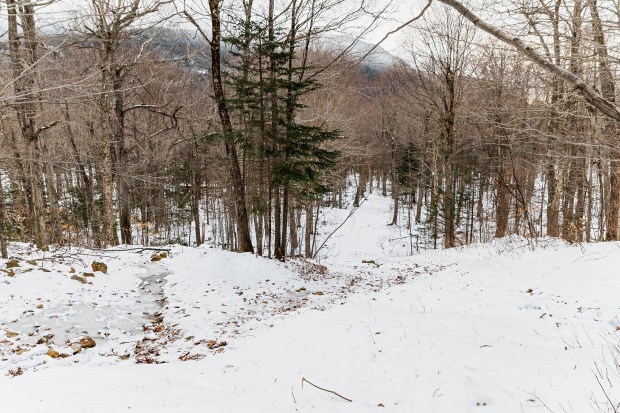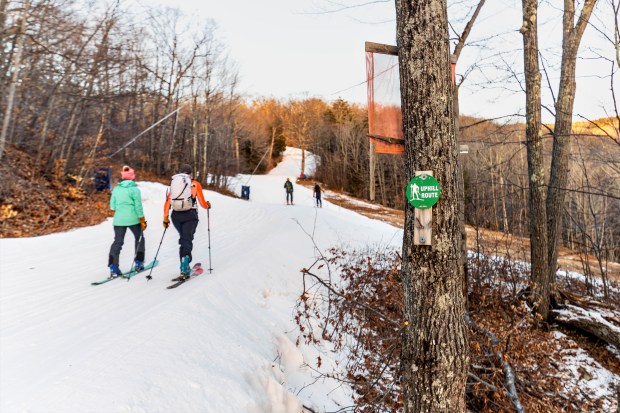Early last February, at the Mount Washington Backcountry Ski Festival in New Hampshire, the organizers faced an increasingly common problem: terrible snow.
Four days of temperatures over 40 degrees combined with an already shallow snowpack had rendered many backcountry ski zones unskiable. Up on Mount Washington, where the higher elevations usually mean colder temperatures, what had been soft, wet snow had hardened into ice when the temperature dropped in the late morning.
Corey Fitzgerald, 36, owner of Northeast Mountaineering in Glen, New Hampshire, who was supposed to photograph a backcountry tour group on the festival’s third day, headed to an area called Gulf of Slides to check out the conditions. He skied into one of the slides ahead of the group and found that “it was just bulletproof,” or so icy that his skis just bounced off the surface, Fitzgerald said.
“I thought people were just going to fall down the gully,” he said. “And the snow was so low that there was an ice bulge still visible in the middle.”
One by one, each skier edged their way down the icy slope, but it was far from the best ski run of their lives.
Alpine ski touring, as the sport is known, involves climbing up mountains using special equipment, then skiing down, and it has been booming. There was a 16% increase in the total number of people who participated in ski touring nationwide during the 2022-23 ski season compared with the previous year, according to Snowsports Industries Americas, a winter outdoor industry trade association. New Englanders accounted for nearly 4% of the total number of skiers, according to the group’s participation study.
The surge can largely be attributed to gear advancements such as lighter skis and split snowboards, to which skiers attach “skins” that grip the snow and allow them to climb. Special bindings let skiers’ and riders’ heels stay free for climbing, then lock into place for descents.
Add in the rising cost of lift tickets at resorts and an increased desire for solitude fueled by the pandemic, and you get a spike in interest.
At the same time, especially in the Northeast, winters are getting shorter; more “weather whiplash” events, where rapid swings in temperature result in the thawing and refreezing of the snowpack, are occurring; and natural snow is becoming less reliable.
A study published in a 2021 issue of the journal Northeastern Naturalist concluded that Mount Washington’s snow season has decreased by 1.7 days per decade between 1931 and 2018 and snowfall totals have declined by just over 8 inches per decade over the same period.
According to the report, New England’s warming trends are outpacing the rest of the country. Last year, it wasn’t until late February that skiable backcountry terrain could be reliably found in the Northeast. This year looks similar: Just before Christmas vacation week, a devastating storm brought more than 5 inches of rain in 24 hours to some parts of New England decimating any existing snowpack. A big snowstorm in early January was followed by warming temperatures and rain.
Different terrain
In the West, much of the backcountry skiing takes place on wide-open slopes above the tree line or in forests, where trees tend to be spaced far apart. In the densely forested Northeast, backcountry skiing is limited to human-made glade runs, creek beds or the scant above-tree-line terrain.
Less snow also means fewer avalanches, which might seem like a good thing. They can be deadly when triggered by a person, but they also serve to keep terrain open and navigable for skiers and riders.
In New England’s Alpine ecosystem, a shallower snowpack and shorter winter is allowing small trees to grow in open gullies. They hold the snow in place, resulting in smaller and less frequent avalanches, which in turn result in more trees and less skiable terrain. Like the so-called ice-albedo effect in polar regions, where a loss of reflective surfaces on the polar ice amplifies a growing climate crisis, the retreat of these ski lines has entered a similar feedback loop. What’s more, climatic changes mean that trees grow at higher elevations — approximately 3 meters higher every decade for the past four decades — according to a study published in the Journal of Biogeography last January.
Jordon Tourville, a postdoctoral research fellow for the Appalachian Mountain Club who worked on the study, said the change was largely because of an increase in the length of the growing season. “Like most things in science, there are a lot of factors at play, but it all comes back to these global change drivers — especially temperature,” he said. “Because that impacts both the vegetation growth and the amount of snow we have.”
Mark Synnott, 54, a professional skiing and climbing guide and accomplished mountaineer from Jackson, New Hampshire, has watched as some of his favorite ski lines have been reclaimed by the forest.
“There are gullies I was skiing just 10 years ago that aren’t really there anymore,” he said. “We used to get these robust avalanche cycles that would clear the terrain out, but now, less snow is resulting in smaller avalanches. Some of these gullies are literally disappearing before my eyes.”
‘Uphilling,’ the next best thing

Unreliable conditions are also forcing would-be backcountry skiers onto human-made snow, leading to a growth in “uphilling,” or touring inbounds at ski resorts, where skiers skin up the side of groomed slopes, then ski down resort trails that can offer machine-made snow.
Vermont’s Bolton Valley offers access to both lift-served terrain and an extensive network of backcountry zones.
Its backcountry program, launched in 2017, offers guided trips into off-piste terrain, taking advantage of natural drainages that serve as perfect ski descents. The resort also offers a nordic, backcountry and uphill pass that starts at $20 midweek and allows skiers to hike inbounds and then ski down either the groomed or backcountry terrain.
The decision to lean into the backcountry trend, despite warming winters, was justified by the mountain’s high elevation, north-facing slopes known for holding snow longer, and its proximity to Lake Champlain, which often drops a layer of lake-effect snow on the mountain, said Adam DesLauriers, Bolton Valley’s special projects director.
There is often enough snow to ski in the backcountry from early January until May, DesLauriers said, but last season was cut short by multiple weeks on either end. What he calls “weird” weather events — code for rain — contributed to an abrupt end to the season, and an increase in inbounds uphillers.
Many resorts have been adding uphill-only passes, which often cost about $20 (although some don’t require a fee), designating specific uphill trails, and implementing policies to manage the ongoing increase in users. Some resorts, including Black Mountain and Saddleback, both in Maine, have even designated uphill-only trails that lift-riding skiers and riders aren’t allowed to ski down.
For backcountry-focused skiers and riders, “if the snowpack isn’t there, then ski resorts are the next best thing,” said Ed Warren, who in 2023 founded Uphill New England, a multimountain ski pass for skinning. The nonprofit pass, which is good at a dozen ski areas in New England and costs $215 for the season, works similarly to multimountain passes such as Epic or IKON. But rather than let pass holders ride the chairlifts, it only allows them to access the terrain, which can be hiked up and skied down.
Investing in a dying sport?
Conditions are only one part of the equation when it comes to backcountry skiing — not everywhere has natural terrain that can be skied without human intervention. Across New England, nonprofit organizations are attempting to tackle this issue by creating gladed ski zones.
Granite Backcountry Alliance, which was formed in 2016 by Tyler Ray, 45, of North Conway, New Hampshire, has worked to thin 17 densely wooded areas to create backcountry ski runs to meet the demand in New Hampshire and western Maine. But the irony of investing time and energy to develop a sport that relies so heavily on consistent snowfall and cold winters at a time when both are in decline isn’t lost on Ray.
“Last year, there was only one week of great skiing,” he recalled. “And this is being considered as we embark upon new projects. Our goal is to continue migrating farther north, seeking out colder climates, north-facing aspects and higher elevations.”
Ray feels the biggest threat is to the small businesses that support the sport. As windows of opportunity for backcountry skiing become less frequent, he wonders who will be left to provide gear and information about current conditions.
This season’s lack of snowfall had Umiak Outfitters, a gear and touring company in northern Vermont, running only 10% of its usual tours going into the holidays because of lack of snowpack. It is looking “at adding more activities that are less snow-based,” said company owner Steve Brownlee. “Backcountry consumers might have to start thinking more of March as a great time to come and do backcountry tours.”
Synnott is among those who’d rather be in the backcountry — but will settle for the ski resorts. He recalled an afternoon in mid-January last year, as he skinned up the slopes at Wildcat Mountain. He had wanted to ski the natural terrain on Mount Washington, New England’s highest peak, but there wasn’t enough snow, so he had to settle for machine-made.
When Synnott reached the summit, he peered across the valley at Mount Washington, its upper reaches shrouded in clouds. A storm that would dump 10 inches of snow on its slopes was in the forecast, finally promising a possible start to the backcountry ski season. But the storm was still days away, serving only as a light at the end of what had been a dark tunnel.
The conditions on Wildcat were “surprisingly good,” he said. “Not being able to ski on Washington was a little frustrating, but honestly, I was just glad to have something to skin.”



